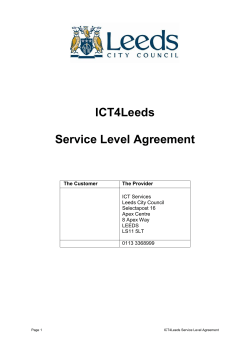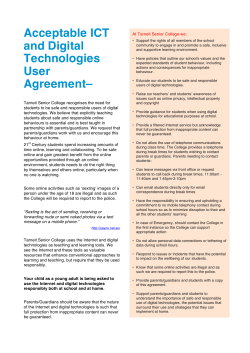
How to Evaluate E-Government? Different Methodlogies and Methodes 1. Introduction Marcin Sakowicz
How to Evaluate E-Government? Different Methodlogies and Methodes Marcin Sakowicz1 1. Introduction The driving objective of this paper is to identify different approaches to measure the development of egovernment and propose some indicators appropriate for countries of Central and Eastern Europe. The first question taken into consideration is how e-government should be understood. The second area of examination focuses on e-government evaluation methods adopted in leading information technology advanced countries like USA and European Union. My argument is that in many cases our perceiving of e-government is limited or simplified and thus it is evaluated improperly. The third vital issue to ponder on is whether should we apply the same criteria of evaluation in post-socialistic countries or employ another ones. Firstly, I would like to point out the need for the defining the concept of e-government. In 2001 Taylor Nelson Sofres (TNS) undertook a major global study focused on impact of the Internet on government2. E-government was defined as any usage of government online at all levels (federal, state, local). But I doubt if this survey bring clear message about state of art in the field of e-government in analysed countries. 2. E-government or e-governance? The interpretation of e-Government is quite broad and divergent. General definition describes e-government as the use of information and communication technologies (ICT) to transform government by making it more accessible, effective and accountable3. Usually we identify four or five stages of e-government development described as: information available on-line one way interaction two - way interaction full online transaction, including delivery and payment In more detailed view, realisation of ICT projects may refer to narrow and broad areas of e-Government. In first case, “e-Government in small” is associated with implementation of administrative processes, within domain of e-Administration. Broadly defined, electronic government can include all information and communication technology (ICT) to support government operations, engage citizens, and provide government services. Therby, broader approach embrace the whole range of governance and administrative projects including e-services, edemocracy, e-voting, e-justice and in some way even e-education or e-healthcare. Clearly, e-government is much more than gathering the information, downloading files or making online transaction. Furthermore, the set of concepts related to the use of ICT has been enriched with the notion of e-governance as a result of new approach of public problem solving4. We are witnessing the transition from a consolidaded model of ‘big government” – centralised, hierarchical and operating in close networks to new model of governance based in self-organising interorganisational networks exchanging local and global knowledge in the digital economy. In today’s world neither politicians nor civil servants and administration staff are exclusively responsible for shaping strategies and policies of a given country or local community. Narrow approach to egovernment may lead to technocratic government or transforming bureacracy into infocracy. On contrary, egovernance assumes online engagement of many stakeholders in the process of shaping, debating and implementing public policies. Within this broad definition we can identify four dimensions of e-governance5: E-services – This term describes the use of electronic delivery for government information, programs, strategies and services. These are available on-line “24h/7days”. It also refers to Electronic Service Delivery (ESD) and such expression as ‘one-stop service centers”. The latter describes situation in which citizen needs are met through a single contact with the government. In many cases it assumes a modernised frontoffice but not necessarily redesigned back office capacity. At the same time, e-services emphasise innovative forms of citizen involvement and offer services that demonstrate serious valuation of citizens as customer of 1 Warsaw School of Economics, Department of Public Administration, Email: msakow@sgh.waw.pl Government Online, an international perspective, 2001 Benchmarking Research Study, TNS 3 E-Government Handbook, http://www.cdt.org/egov/handbook/, 04-03-2003 4 The tools of government, A Guide to the New Governance, Lester M. Salomon (ed.), Oxford University Press 2002, p. 9-18 5 M. Sakowicz, Electronic Promise for Local and Regional Communities, LGB Brief, Winter 2003, p. 24-28 2 1 administration. The strategic challenge is to deliver services to members of public along with dimensions such as quality, convenience and cost. E-management – While e-Services focus on extra-organisational relations, e-management (e-administration) refers to the behind-the-scene information systems supporting the management and administrative functions of public institutions, including data and information management, electronic records maintenance and cross-departmental flow of information. E-governance initiatives within this domain deal particularly with improving management of government, from streamlining business processes to improving crossdepartmental flow of information. Effective usage of ICT requires a new organisational culture in addition to new staff teams focused on performance, customer services and response to citizen input. The solutions to problem of e-management lie in the implementation of services designed around possible life events or lifeepisode” approach and the adaptation and integration of back-office processes6. E-democracy - This is the most difficult to generate and sustain feature of e-Governance. In framework of e-democracy ICT is used as an instrument to help set agendas, establish priorities, make important policies and participate in their implementation in a deliberative way. It refers to activities that increase citizen involvement including virtual town meeting, open meeting, cyber campaigns, feedback polls, public surveys and community forums (such as through e-consultation, e-voting)7. In short, if egov is successfully implemented new empowered citizens may emerge. They are able to form the Internet biased alliance to respond to various issues and achieve economic and social objectives. E-commerce – This concept is linked to business side of government interaction. In e-commerce the exchange of money for goods and services is conducted over the Internet. For example, citizens paying taxes and utility bills, renewing vehicle registrations, and paying for recreation programs, or government buying offices supplies, and auctioning surplus equipment (through on-line purchasing, e-procurement). 3. Measuring the e-Government, examination of various frameworks 3.1. Methodologies remarks As exemplified in Table 1, there are various approaches to measure the development of e-Government. If you refer to concept of e-governance, it is possible to analyse different maturity level of e-services, e-management, edemocracy and e-commerce. Most of e-Government appraisals try to cover all these issues but the scope of analysis is very often narrow and limited. **TAB.1** As far as methodology is concern, assessment is carried out by combination of several techniques including web surveys, questionnaires, face to face interviews. Research is usually divided into stages. For example, the KEeLAN evaluation framework consisted of two stages8. In the first phase of study 700 web sites of EU municipalities have been scanned with the help of web-scanning tool. This tool composes of a list of questions, which assess the level of service delivery for a predefined selection of services. Within the help of this tool, the level of maturity of the local authority in implementing e-government was computed. As a result of scanning 50 municipalities have been singled out as study cases based on the quality of front-office performance (usability, accessibility, level of interactivity and services, and level of response to external demand of service delivery). The second phase consisted of an online benchmark and sites visits to the 50 selected municipalities. The online benchmark assessed a set of criteria with respect to the organisation and technology behind the front-office. The results from the benchmark formed the basis of the site visit, during which a series of interviews were held with key persons within organisation in order to examine their key factors of success. Having evaluated 50 top local authorities, the final phase of the study concerned the drafting of different models and roadmaps for European Union municipalities to implement e-Government service delivery, based on the organisational characteristics (front- and back-office). In case of UNPAN two methodologies were used in a research on e-government. First, national government websites were analysed for the content and services available that the average citizen would most likely use. The presence, or absence of specific features contributed to determining a country's level of progress. The stages 6 M.Vintar, M. Kunstelj, A. Leben Delivering Better Qaulity Public Servcies through life-event portals, http://www.vus.uni-lj.si/nispa/ , http://www.nispa.sk/news/papers/wg2/Vintar.doc ( April 2002) 7 S. Coleman, J.Gotze, Bowling Together: Online Public Engagement in Policy Deliberation, London: Hansard Society 2002 8 The KEeLAN project (Key Elements for Electronic Local Authorities’ Networks) has been launched in February 2002 as a part of the European fifth Framework Program and Development and is supported by the European Commission, http://www.keelan.elanet.org/egovernment/benchmarking.asp 2 present a straightforward benchmark which objectively assesses a country's online sophistication. Second, a statistical analysis was done comparing the information and communication technology infrastructure and human capital capacity for 144 UN Member States. Most of studies aim to assess overall and general e-government status and therefore take into consideration the whole country, i.e administrations and government at all levels: federal, regional and local. Only 2 out 10 examples shown in Table 1 exclusively focus on regional or local communities (Infoville and KEeLAN projects). However, the local and regional level seems to be essential as the most services are provided by the territorial self-government units and also participation in the public life should be higher at local than at national level. 3.2 Misleading e-government indicators Issues analysed by different evaluations leads to different outcomes and give only part of the answer what is the level of e-government in a given country or local community. Firstly, most evaluations focus on the subject how given countries are prepared for the era of e-Government. Analysed questions are as follows: does web-site allow to send on-line forms, are citizens able to contact with elected representatives by means of new technologies, do countries have enough capability to develop e-Government? This kind of research studies are technologically driven approaches designed to show primarily the level of technologic advancement. This remark refers to such analysis within EU framework. In program eEurope 2002 e-government is analysed by the level of providing the 20 key government public services online that are measured using a four stage framework (Table 2). Use of on-line public services by the public constitutes less important factor. Furthermore, if we consider the whole eEurope report on building information society we can notice that much consideration is devoted to technological aspects9. Most EU targets were stipulated as follows: (by the end of 2001) all schools should have access to the Internet and multimedia resources, (by the end of 2003), all pupils should be ‘digitally literate’ by the time they leave school10. **Tab. 2** Lessons from benchmarking eEurope 2002 led to amendment of employed indicators. According to new framework, eEurope should have a limited number of policy indicators. These should be easy to read and understand. In eEurope2005 Commission proposes 14 policy indicators and 22 supplementary indicators. The new benchmarking criteria are more focused on how the Internet related technologies are used: firms to use ecommerce, schools not only connected but also making full use of the Internet in class; Internet usage in the health sector. The new approach is clearly visible if we compare 23 e-Europe2002 indicators with 14 policy benchmarking indicators for 2005 (Table 3)11. With reference to e-Government issues, the policy indicator is number of basic public services fully available online. Supplementary statistical indicators are percentage of individuals and enterprises using the Internet for interacting with public authorities broken down by purpose (purposes: obtaining information, obtaining forms, returning filled in forms). There also additional supplementary indicators to be the subject of pilot studies with a view to examination of their feasibility at the mid-term review like number of available basic public on-line services with integrated digital back-office processes; public procurement processes that are fully carried out online in % (value) of overall public procurement, percentage of public authorities using open source software. ** Tab. 3** Whereas EU, UNPAN and CAP GEMINI Poland's survey focus only on front-office, KEeLAN framework explores front-office as well as back-office aspects of e-government. All of them focus on supply side of egovernment and not necessarily on the needs and expectations of end users. In case of KEeLAN you simply measure the quality of website by measuring following aspects: Request/Application: covers level of interactivity of the website of local authority by addressing issues related to uploading and downloading the information /application forms, availability of information and modalities of interaction, etc. Handling: covers response to external demand by addressing issues related to reply time and modality of reply to a request, accessibility of databases (editing and monitoring of data) 9 B. Jung, Tworzenie społeczeństwa informacyjnego w Unii Europejskiej I w krajach kandydackich - próba oceny kryteriów in: Polska w przededniu członkostwa w Unii Europejskiej. Nadzieje i obawy, SGH-KES Warszawa 2002, p. 263 - 277 10 eEurope, An information Society for All, Communication on a Commission Initiative for the Special European Council of Lisbon, http://europa.eu.int/information_society/eeurope/ 11 eEurope 2005: Benchmarking indicators, COM (2002) 655 final, http://europa.eu.int/information_society/eeurope/news_library/documents/benchmarking05_en.pdf 3 Help: covers level of interactivity and modalities of support Modality of appearance: user-interface features of the website supprting service delivery. The question of citizen voice and needs is partly answered by Government Online - TNS study. It provides global and national benchmarks relating to the use of government services online and perceptions of safety when providing personal information to Government. But this study solely concentrates on citizens/users and their experience in using ICT with the governments. In turn, eForum survey brings the message about the egovernment uptake from the perspective of public servants. Therefore, as a result of methodology adopted most e-Government developments are assessed from only one perspective either citizens, businesses or public officials. 3.3 The necessity of holistic approach to evaluate e-government Certainly, e-Government is not eBusiness. It is much more. e-Government is about our relationships with our civic institutions and the foundation of our next-generation states and communities. Understanding what citizens and businesses want and how government, private sector and third sector- measure the return on government's Internet investment, is the challenge. Benchmarking the revolution requires new thinking about policy issues and political realities and their impact on citizen and business satisfaction. As an essential step toward further usage of ICT is to look for integrated model of evaluation of e-government development which will associate benefits and all costs and funds earmarked for implementation of new technologies in public domain. The very important and difficult to answer question is: does ICT usage provide benefits commensurate with its costs? Therefore, a necessary evaluation of government should include four domains of e-governance: e-services, e-management, ecommerce and e-democracy compared with expectations and needs of all stakeholders involved, but especially the end users, i.e citizens, businesses, NGOs. In further consideration two approaches are worth mentioned. In the first one, authors of the report on Benchmarking the eGovernment Revolution propose indicator of Experimental Return on Investment (ROI) to measure the effectiveness of e-government12. ROI is a function of three critical variables: • Application and service relevance • Citizens and business satisfaction • Preservation of public trust Application and service relevance lies in its value proposition. The questions are as follows: Does the promise of e-Government meet the needs and improve the lives of citizens? Do ICT solutions help citizens and businesses operate more efficiently and foster better relationship with local authorities? Are local governments more capable of reaching their self-declared objectives? Citizen and business satisfaction index is a measure of effectiveness of ICT usage versus experience of different users. This measure refers to the ability of government to address local peoples’ demands. In order for citizens and businesses to believe that an investment in Internet technologies is worthwhile, they need to be satisfied with Internet based services. Preservation of public trust is the most critical issues facing the development of the Internet today. While the transition toward electronic democracy and electronic delivery of some government services begun, it will be a long and difficult process to achieve true e-government without paying more attention on on-line privacy and security issues and strengthening the level of trust between local authorities and citizens. Second integrated approach is the concept of "Balanced eGovernment" designed by Bertelsman Foundation. This study combines areas of administrative online services for both citizens and other "customers" with the notion of eDemocracy which encompasses the net´s potential for civic participation and better information for citizens. On the basis of the "Balanced eGovernment Scorecard" authors analyze the international good practises in different countries by means of desk research and in-depth interviews. However the problem still exists in case of e-democracy appraisal. e-Democracy means different things for different people and in particular cases it refers to wide-ranging definition of the topic and issues which impact upon it. Themes include: citizen consultation of government policy documents, transparency of government procedures, e-voting. Different studies confirm that e-Democracy is in a very early stage of development. On the other hand, use the Internet and other communication technologies offer potential for increasing citizen participation in the democratic process between elections (citizen participation in the Government’s policy process, parliament’s policy and citizen to citizen interaction). The e-democracy challenge is very promising but this is also a question how far new ICT may change people attitudes to political life and strengthen their 12 Benchmarking the egovernment revolution (2000), Year 2000, report on Citizen and business, Momentum Research Group 4 involvement in policy making. This is rather more complex issue of changing the mindset of human beings. Edemocracy as the whole topic of e-government is not the implementation of technology but transformation of government: politicians, public officials and citizens. Changing the mindset of citizens from a traditional bureaucratic thinking into partnership and more participated approach requires the effort of every citizen. The role of ICT in supporting democratic governance, policy making and peoples’ involvement is still debatable. 4. Conclusions The correct evaluation of e-government should focus on 4 domains of e-government: e-services, e-management, e-democracy and e-commerce. Unfortunately, many decision-makers and researchers still concentrate onesidedly on the provision of electronic services and regard participation as an unnecessary complexity cost factor. Another critical issue for better understanding of e-governance is approach, which focuses less on technology and more on users' actual needs. Therefore core consideration should be devoted to measure effective use of Internet enabled technologies. E-government appraisal should explain how people use the Internet not only for their private tasks but also as a means of involving them in public affairs. Democracy is still not consolidated in CEE countries. Implementation of ICT will not guarantee stable democratic governance but may be perceived as tool for upgrading operations of public administration. Private, public and NGO’s efforts should be linked in order to built truly effective, responsive and accountable government. The most important is mental shift, building trust and of transformation of joint relations into cooperation based on partnership in achieving common goals. Last but not least, e-government appraisal must present criteria against with outcomes are weighed. All CEE and FSU countries face budgetary constraints. Thus, a concern whether public money is wisely and efficiently spent is essential. References: Balanced eGovernment (2002) - Connecting Efficient Administration and Responsive Democracy, Begix, http://www.begix.de/en/index.html Benchamrking the eGovernment Revolution: Year 2000 Report on Citizen and Business Demand, Momentum Research Group, http://www.momentumresearchgroup.com/pdf/eGov_report.pdf Benchmarking E-government: A Global Perspective Assessing the Progress of the UN Member States, http://www.unpan.org/egovernment2.asp Coleman S., Gotze J., (2002) Bowling Together: Online Public Engagement in Policy Deliberation, London: Hansard Society e-Forum for European e-Public Services, Public Services Requirements Survey (2002), http://www.eu-forum.org e-Government Benchmarking Electronic Service Delivery (July 2001), a report of the e-Envoy, http://www.eenvoy.gov.uk/oee/oee.nsf/sections/reports-top/$file/int_comparisons.htm E-public services in Poland, CAP GEMINI ERNST&YOUNG, http://www.pl.cgey.com/news/index.shtml#egov2 Jung B., (2002) "Tworzenie społeczeństwa informacyjnego w Unii Europejskiej I w krajach kandydackich próba oceny kryteriów." in: Polska w przededniu członkostwa w Unii Europejskiej. Nadzieje i obawy, Warszawa: SGH-KES, p. 263 - 277 KEeLAN, http://www.keelan.elanet.org/egovernment/ Sørensen P., Abildgaard F., (November http://digitalsites.infoville.net/index.htm 2000), Infoville, Socio-economic impact report, Taylor Nelson Sofres Government Online Study 2001, http://www.tnsofres.com/gostudy/index.cfm Vintar M., Kunstelj M., Leben A. (2002) Delivering Better Qaulity Public Servcies through life-event portals, http://www.vus.uni-lj.si/nispa/ , http://www.nispa.sk/news/papers/wg2/Vintar.doc 5 Table 1: Selected example of evaluation/benchmarking of egovernment Project name Methodology of collecting and Character features of evaluation - criteria, primary (organisation) analysing data. The scope of goal and result analysis e-Europe, EU In the field of information society, E-government is measured by comparison of on-line national statistics offices, all tiers of development of 20 key public services government UNPAN Website evaluation along with The study's primary goal is to present objectively (The United Nations Questionnaire sent to public sector facts and conclusions that define a country's eOnline Network in professionals, government environment and demonstrate its Public Administration National e-government programs, capacity (or lack of) to sustain online development. and Finance) e-government is defined as: comparative analysis of fundamental information utilising the Internet and the world- technology (IT) indicators and critical human capital wide-web for delivering measures for each UN Member State. government information and services to citizens. e-Government interviews, targeted questionnaires The 2001 study has focussed on a range of backBenchmarking worldwide, selected advanced office and wider e-government issues, such as Electronic Service countries accessibility and interoperability. Delivery (July 2001, eEnvoy) KeeLAN Local and Regional Level To elaborated road-maps for e-government webscanning of 700 websites and development at local level, to find ‘top’ websites on then thorough examination along the basis of: Request/Application; Handling: Help; with interviews in the 50 Case Modality of appearance Studies Analysed issues: business model adopted, transformation of workflow, responsibilities and work processes and financial, legal, social and cultural considerations Eforum National, Regional and Local range ICT means, e-government perceived expectations and Questionnaires addressed primary fears from the point of view of the a. citizens, to civil servants, face to face businesses, civil servants, government, barriers and interview in order to collect drivers in the process of e-Government information helping to assess broad implementation trends in e-government development in Europe. Momentum Research interviews from citizen and Main criteria are: Application and service relevance; Group business sector Citizens and business satisfaction; Preservation of public trust The Government The report is designed to measure Online Study (GO), the impact of the Internet on Key Questions Answered: What are the levels of eTaylor Nelson Sofres government globally and nationally. government usage? How is e-government being The study is a result of telephone used? Is safety issue a barrier to e-government interviews with over 29,000 uptake? How does e-government uptake compare to individuals across 27 countries. internet use globally? E-public services in Poland, CAP GEMINI ERNST&YOUNG (2002, 2003) Balanced EGovernment Connecting Efficient Administration and Responsive Democracy Infoville Front-office, in Poland 2002, 388 institutions analysed, 74 % of them have got their own web site, average is 21% 12 services was the subject of closer analysis along with more than 50 individual conversations were conducted Web-based survey on Electronic Public Services focus groups and large-scale postal or face-to-face questionnaires to citizen end users in 8 municipalities Focus on end users, main question how people use local websites? Various dimensions of e-democracy and egovernment services, 49 criteria in the five fields: benefit, efficiency, participation, transparency, change management were analysed 6 Table 2: List of public services analysed in the course of e-Europe as the basis of e-government development Services for the Citizens Services for Businesses 1. Income taxes 1. Social contribution for employees 2.Job search 2. Corporate tax 3. Social security benefits 3. VAT 4. Personal documents 4. Registration of a new company 5. Car registration 5. Submission of statistical data 6. Application for building permission 6. Customs declarations 7. Declaration to the police 7. Environment-related permits 8. Public libraries 8. Public Procurement 9. Birth and marriage certificates 10. Enrolment in higher education 11. Announcement of moving 12. Health-related services Source: eEurope 2002; Impact and Priorities, COM 2001 140 final , Brussels 13.3 2001 7 Table 3: List of eEurope Benchmarking indicators eEurope 2002 1.Percentage of population who regularly use the Internet 2.Percentage of households with the Internet access at home 3.Internet access costs 4. Speed of interconnections and services available between and within national research and education networks (NRENs) within EU and world-wide 5. Number per secure servers per million inhabitants 6. Percentage of Internet-using public that have experienced security problems 7. Number of computers per 100 pupils in primary/secondary/tertiary levels 8. Number of computers connected to the Internet per 100 pupils in primary/secondary/tertiary levels 9. Number of computers with high speed connections to the Internet per 100 pupils in primary/secondary/tertiary levels 10. Percentage of teachers using the Internet for noncomputing teaching on a regular basis 11. Percentage of workforce with (at least) basic IT training 12. Number of places and graduates in ICT related third level education Europe 2005 policy indicators (14) A Citizens’ access to and use of the Internet A1. Percentage of households or individuals with internet access at home A2. Percentage of individuals regularly using the Internet B Enterprises’access to and use of ICTs B1. Percentage of persons employed using computers connected to the Internet, in their normal work routine Internet access costs C.1 Costs of Internet access broken down by different frequency of use: 20, 30, 40 hrs/month, unmetered rates D. e-governement D1. No. Of basic public services fully available on-line E e-learning E.1 Number of pupils with Internet connections (broadband/nonbroadband) F. e-health F1. Percentage of Population (aged 16 and over ) using Internet to seek health information whether for themselves or others. F.2. Percentage of general practitioners using electronic patients records G. Buying and selling on-line G.1 Percentage of enterprise's total turnover from ecommerce H. e-business readiness H1 e-business index (composite indicator) I Internet users’ experience and usage regarding ICTsecurity I1 Percentage of individuals with Internet access having encountered security problems I2 Percentage of enterprises with Internet access having encountered security problems J Broadband penetration J1.Percentage of enterprises with broadband access J2.Percentage of households and individuals with broadband access J3.Percentage of public administrations with broadband access 13. Percentage of workforce using telework 14. Number of Public Internet Points (PIAP) per 1000 inhabitants 15. Percentage of central government websites that conform to the WAI accessibility guidelines at A level 16. Percentage of companies that buy and sell over the Internet 17. Percentage of basic public services available on-line 18. Public use of government on-line services – for information/ for submission of forms 19. Percentage of public procurement which can be carried out on-line 20. Percentage of health professionals with Internet access 21. Use of different categories of web content by health professionals 22. Percentage of EU web sites in the national top 50 visited 23. Percentage of motorway network (vs. Total length of network) equipped with congestion information and management systems Source: List of eEurope Benchmarking indicators, http://europa.eu.int/information_society/eeurope/benchmarking/indicator_list.pdf; eEurope2005:benchmarking indicators; http://europa.eu.int/information_society/eeurope/news_library/documents/benchmarking05_en.pdf 8
© Copyright 2025




















